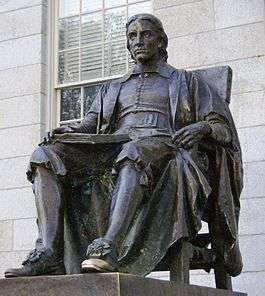Peabody Terrace
Coordinates: 42°21′58″N 71°6′56″W / 42.36611°N 71.11556°W
Peabody Terrace, on the north bank of the Charles River in Cambridge, Massachusetts, is a Harvard University housing complex primarily serving graduate students, particularly married students and their families. Designed in the brutalist style[1] and constructed in 1964, its three-story perimeter grows to five and seven stories within, with three interior 22-story towers.[2]
It has been described as "beloved by architects and disliked by almost everyone else."[3]
Description
Peabody Terrace was completed in 1965 at a cost of $8.5 million.[2]
On 5.9 acres (2.4 ha), the 650,000-square foot (60,000 m2) complex consists of some 500 apartments (a mixture of "efficiencies" and one-, two-, and three-bedroom units—
Peabody Terrace participates in Harvard University's "Graduate Commons" program,[5] which organizes entertainment, educational events, and local trip for tenants, and is home to a resident faculty director.
Controversy arose in 2009 when small amounts of the toxic chemical Polychlorinated Biphenyl were found[6] within the apartment complex. Renovations continue in an effort to refurbish the towers and remove all traces of the chemical.
Reception
In the words of architecture critic Robert Campbell, the exterior reflects the desire of its designer, Harvard Graduate School of Design Dean Josep Lluís Sert, to "bring the color and life of the Mediterranean to the white cubist architecture of northern Europe".[2] It has also been called "an extension of Le Corbusier's communal prototype, the Unité d'Habitation".[7]
Originally designated as housing for married students, the partially completed project appeared in a Harvard Crimson photo over the caption, "University Moves to Thwart Early Marriages", and the Crimson later called it "well on the way to being just as hideous" as another Sert-designed building, Harvard's new administrative high-rise Holyoke Center.[8] Nonetheless it received the Boston Society of Architects' Harleston Parker Medal and the American Institute of Architects Gold Medal.[2]
In 1965 Progressive Architecture said Sert had achieved "an efficiently workable interior arrangement, a lively sequence of exterior spaces, and a fluent continuity from low to high, and from old to new structures."[9] But by 1994 the same publication saw Peabody Terrace as "an embarrassment to Harvard, and the last resort of graduate students who couldn’t find a better place to live."[10] (The living units were renovated 1993–1995 and the common areas overhauled in 2013.[4])
References
- ↑ https://books.google.co.uk/books?id=sPGdBxzaWj0C&pg=PA356&dq=brutalist+%22Peabody+Terrace%22&hl=en&sa=X&ei=kb2iVI3MFI38aMPpgaAL&ved=0CCAQ6AEwAA#v=onepage&q=brutalist%20%22Peabody%20Terrace%22&f=false
- 1 2 3 4 5 "AD Classics: Peabody Terrace". arch daily.

- ↑ Campbell, Robert (Summer 2004). "Why Don't the Rest of Us Like the Buildings the Architects Like?". Bulletin of the American Academy of Arts and Sciences: 22.
- 1 2 "Peabody Terrace". Harvard University Housing.

- ↑ "Graduate Commons Program | Harvard University Housing". www.huhousing.harvard.edu. Retrieved 2016-09-28.
- ↑ "Peabody Terrace Complex Undergoing Renovations | News | The Harvard Crimson". www.thecrimson.com. Retrieved 2016-09-28.
- ↑ Shand-Tucci, Douglass (1999). Built in Boston: City and Suburb, 1800–2000. Univ of Massachusetts Press. p. 289. ISBN 1-55849-201-1.

- ↑ "Dean Sert's Buildings". Harvard Crimson. October 8, 1963.
- ↑ "Harvard's new married student housing". Progressive Architecture. 45: 122–133.
- ↑ Dixon, John Morris (December 1994). "Yesterday's paradigm, today's problem". Progressive Architecture. 75 (6): 100–7.
